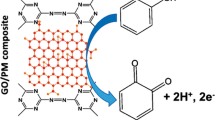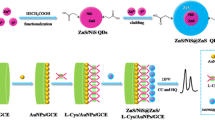Abstract
A nanocomposite consisting of electrochemically reduced graphene oxide, poly(Eriochrome black T) and gold nanoparticles (ERGO-pEBT/AuNPs) was prepared for the simultaneous detection of resorcinol (RC), catechol (CC), and hydroquinone (HQ). The electrochemical oxidation of HQ, CC, and RC was analysed by using cyclic voltammetry and differential pulse voltammetry. Three well-separated potentials were found at 166, 277, and 660 mV (vs. Ag/AgCl) for HQ, CC, and RC, respectively The linear ranges were 0.52–31.4, 1.44–31.2, and 3.8–72.2 μM for HQ, CC, and RC, respectively. The limits of detections (LODs) for both individual and simultaneous detections are negligibly different are (15, 8, and 39 nM, respectively).

Voltammetric determination of hydroquinone, catechol, and resorcinol at ERGO-pEBT/AuNPs resulted in high peak currents and outstanding oxidation potential separation of the analytes.





Similar content being viewed by others
References
Khodaei MM, Alizadeh A, Pakravan N (2008) Polyfunctional tetrazolic thioethers through electrooxidative/michael-type sequential reactions of 1, 2-and 1, 4-dihydroxybenzenes with 1-phenyl-5-mercaptotetrazole. J Org Chem 73(7):2527–2532
Zeng Z, Qiu W, Huang Z (2001) Solid-phase microextraction using fused-silica fibers coated with sol− gel-derived hydroxy-crown ether. Anal Chem 73(11):2429–2436
Huang YH, Chen JH, Sun X, Su ZB, Xing HT, Hu SR, Weng W, Guo HX, Wu WB, San He Y (2015) One-pot hydrothermal synthesis carbon nanocages-reduced graphene oxide composites for simultaneous electrochemical detection of catechol and hydroquinone. Sensors Actuators B Chem 212:165–173
Pistonesi MF, Di Nezio MS, Centurión ME, Palomeque ME, Lista AG, Band BSF (2006) Determination of phenol, resorcinol and hydroquinone in air samples by synchronous fluorescence using partial least-squares (PLS). Talanta 69(5):1265–1268
Lin Z, Sun X, Hu W, Yin Y, Chen G (2014) Sensitive determination of positional isomers of benzenediols in human urine by boronate affinity capillary electrophoresis with chemiluminescence detection. Electrophoresis 35(7):993–999
Zhao L, Lv B, Yuan H, Zhou Z, Xiao D (2007) A sensitive chemiluminescence method for determination of hydroquinone and catechol. Sensors 7(4):578–588
Liu X, Luo L, Ding Y, Kang Z, Ye D (2012) Simultaneous determination of L-cysteine and L-tyrosine using Au-nanoparticles/poly-eriochrome black T film modified glassy carbon electrode. Bioelectrochemistry 86:38–45
Wang H-F, Wu Y-Y, Yan X-P (2013) Room-temperature phosphorescent discrimination of catechol from resorcinol and hydroquinone based on sodium tripolyphosphate capped Mn-doped ZnS quantum dots. Anal Chem 85(3):1920–1925
Yao H, Sun Y, Lin X, Tang Y, Huang L (2007) Electrochemical characterization of poly (eriochrome black T) modified glassy carbon electrode and its application to simultaneous determination of dopamine, ascorbic acid and uric acid. Electrochim Acta 52(20):6165–6171
Li D-W, Li Y-T, Song W, Long Y-T (2010) Simultaneous determination of dihydroxybenzene isomers using disposable screen-printed electrode modified by multiwalled carbon nanotubes and gold nanoparticles. Anal Methods 2(7):837–843
Velmurugan M, Karikalan N, Chen S-M, Dai Z-C (2017) Studies on the influence of β-cyclodextrin on graphene oxide and its synergistic activity to the electrochemical detection of nitrobenzene. J Colloid Interface Sci 490:365–371
Yin H, Zhang Q, Zhou Y, Ma Q, Liu T, Zhu L, Ai S (2011) Electrochemical behavior of catechol, resorcinol and hydroquinone at graphene–chitosan composite film modified glassy carbon electrode and their simultaneous determination in water samples. Electrochim Acta 56(6):2748–2753. https://doi.org/10.1016/j.electacta.2010.12.060
Palanisamy S, Karuppiah C, Chen SM, Muthupandi K, Emmanuel R, Prakash P, Elshikh MS, Ajmal Ali M, Al-Hemaid FM (2015) Selective and simultaneous determination of Dihydroxybenzene isomers based on green synthesized gold nanoparticles decorated reduced graphene oxide. Electroanalysis 27(5):1144–1151
Sabbaghi N, Noroozifar M (2019) Nanoraspberry-like copper/ reduced graphene oxide as new modifier for simultaneous determination of benzenediols isomers and nitrite. Anal Chim Acta 1056:16–25. https://doi.org/10.1016/j.aca.2018.12.036
Moghaddam MR, Ghasemi JB, Norouzi P, Salehnia F (2019) Simultaneous determination of dihydroxybenzene isomers at nitrogen-doped graphene surface using fast Fourier transform square wave voltammetry and multivariate calibration. Microchem J 145:596–605. https://doi.org/10.1016/j.microc.2018.11.009
Li Z, Yue Y, Hao Y, Feng S, Zhou X (2018) A glassy carbon electrode modified with cerium phosphate nanotubes for the simultaneous determination of hydroquinone, catechol and resorcinol. Microchim Acta 185(4):215
Mohammed Modawe Alshik Edris N, Abdullah J, Kamaruzaman S, Saiman MI, Sulaiman Y (2018) Electrochemical reduced graphene oxide-poly(eriochrome black T)/gold nanoparticles modified glassy carbon electrode for simultaneous determination of ascorbic acid, dopamine and uric acid. Arab J Chem 11(8):1301–1312. https://doi.org/10.1016/j.arabjc.2018.09.002
Geng M, Xu J, Hu S (2008) In situ electrogenerated poly (Eriochrome black T) film and its application in nitric oxide sensor. React Funct Polym 68(8):1253–1259
Zhai X, Efrima S (1996) Reduction of silver ions to a colloid by eriochrome black T. J Phys Chem 100(5):1779–1785
Tukimin N, Abdullah J, Sulaiman Y (2018) Review-electrochemical detection of uric acid, dopamine and ascorbic acid. J Electrochem Soc 165(7):B258–B267
Prathap MA, Satpati B, Srivastava R (2013) Facile preparation of polyaniline/MnO2 nanofibers and its electrochemical application in the simultaneous determination of catechol, hydroquinone, and resorcinol. Sensors Actuators B Chem 186:67–77
Huang J, Zhang X, Zhou L, You T (2016) Simultaneous electrochemical determination of dihydroxybenzene isomers using electrospun nitrogen-doped carbon nanofiber film electrode. Sensors Actuators B Chem 224:568–576
Wang Y, Xiong Y, Qu J, Qu J, Li S (2016) Selective sensing of hydroquinone and catechol based on multiwalled carbon nanotubes/polydopamine/gold nanoparticles composites. Sensors Actuators B Chem 223:501–508
Dave PN, Kaur S, Khosla E (2011) Removal of eriochrome black-T by adsorption on to eucalyptus bark using green technology. Indian Journal of Chemical Technology 18:53–60
Dave PN, Kaur S, Khosla E (2011) Removal of eriochrome black-T by adsorption on to eucalyptus bark using green technology
Erogul S, Bas SZ, Ozmen M, Yildiz S (2015) A new electrochemical sensor based on Fe3O4 functionalized graphene oxide-gold nanoparticle composite film for simultaneous determination of catechol and hydroquinone. Electrochim Acta 186:302–313
Li X, Xu G, Jiang X, Tao J (2014) Highly sensitive and simultaneous determination of hydroquinone and catechol at thionine/graphene oxide modified glassy carbon electrodes. J Electrochem Soc 161(9):H464–H468
Du J, Ma L, Shan D, Fan Y, Zhang L, Wang L, Lu X (2014) An electrochemical sensor based on the three-dimensional functionalized graphene for simultaneous determination of hydroquinone and catechol. J Electroanal Chem 722-723:38–45. https://doi.org/10.1016/j.jelechem.2014.02.024
Zidan M, Zawawi RM, Erhayem M, Salhin A (2014) Electrochemical detection of paracetamol using graphene oxide-modified glassy carbon electrode. Int J Electrochem Sci 9:7605–7613
Tian F, Li H, Li M, Li C, Lei Y, Yang B (2017) Synthesis of one-dimensional poly (3, 4-ethylenedioxythiophene)-graphene composites for the simultaneous detection of hydroquinone, catechol, resorcinol, and nitrite. Synth Met 226:148–156
Chen Y, Liu X, Zhang S, Yang L, Liu M, Zhang Y, Yao S (2017) Ultrasensitive and simultaneous detection of hydroquinone, catechol and resorcinol based on the electrochemical co-reduction prepared Au-Pd nanoflower/reduced graphene oxide nanocomposite. Electrochim Acta 231:677–685. https://doi.org/10.1016/j.electacta.2017.02.060
Zhang H, Bo X, Guo L (2015) Electrochemical preparation of porous graphene and its electrochemical application in the simultaneous determination of hydroquinone, catechol, and resorcinol. Sensors Actuators B Chem 220:919–926. https://doi.org/10.1016/j.snb.2015.06.035
Penner N, Nesterenko P, Rybalko M (2001) Use of hypercrosslinked polystyrene for the determination of pyrocatechol, resorcinol, and hydroquinone by reversed-phase HPLC with dynamic on-line preconcentration. J Anal Chem 56(10):934–939
Acknowledgements
This research has been funded by Universiti Putra Malaysia Research Grant (GP IPS/2016/9512900). Thanks also to the Organization for Women in Science for the Developing World (OWSD) and Sida (Swedish International Development Cooperation Agency) for the scholarship to Nusiba Mohammed Modawe Alshik.
Author information
Authors and Affiliations
Corresponding author
Ethics declarations
The author(s) declare that they have no competing interests.
Additional information
Publisher’s note
Springer Nature remains neutral with regard to jurisdictional claims in published maps and institutional affiliations.
Electronic supplementary material
ESM 1
(DOCX 2.19 mb)
Rights and permissions
About this article
Cite this article
Mohammed Modawe Alshik Edris, N., Abdullah, J., Kamaruzaman, S. et al. Voltammetric determination of hydroquinone, catechol, and resorcinol by using a glassy carbon electrode modified with electrochemically reduced graphene oxide-poly(Eriochrome black T) and gold nanoparticles. Microchim Acta 186, 261 (2019). https://doi.org/10.1007/s00604-019-3376-y
Received:
Accepted:
Published:
DOI: https://doi.org/10.1007/s00604-019-3376-y




